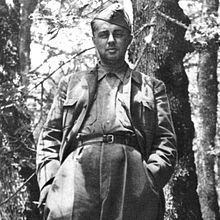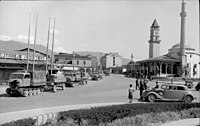German occupation of Albania
Albanian Kingdom | |||||||||||
|---|---|---|---|---|---|---|---|---|---|---|---|
| 1943–1944 | |||||||||||
| Motto:"Shqipëria Shqiptarëve, Vdekje Tradhëtarëve" "Albania for the Albanians, Death to the Traitors"[1] | |||||||||||
| Anthem:Himni i Flamurit Hymn of the Flag | |||||||||||
 The Albanian Kingdom 1943–1944 | |||||||||||
| Status | Client stateofNazi Germany | ||||||||||
| Capital | Tirana 41°31′N19°48′E/ 41.517°N 19.800°E | ||||||||||
| Common languages | Albanian | ||||||||||
| Demonym(s) | Albanian | ||||||||||
| Government | Regentconstitutional monarchyundermilitary occupation | ||||||||||
| Head of State | |||||||||||
• 1943 | Ibrahim Biçakçiu[note 1] | ||||||||||
• 1943–1944 | Mehdi Frashëri[note 2] | ||||||||||
| Prime Minister | |||||||||||
• 1943–1944 | Rexhep Mitrovica | ||||||||||
• 1944 | Fiqri Dine | ||||||||||
• 1944 | Ibrahim Biçakçiu | ||||||||||
| Legislature | Regency Council | ||||||||||
| Historical era | World War II | ||||||||||
• German takeover | 8 September 1943 | ||||||||||
• Communist Takeover & Liberation | 29 November 1944 | ||||||||||
| Area | |||||||||||
| 1939 | 28,748 km2(11,100 sq mi) | ||||||||||
| 1940-1943 | 52,667 km2(20,335 sq mi) | ||||||||||
| Population | |||||||||||
• 1939 | 1,063,893 | ||||||||||
• 1940-1943 | 1,701,463 | ||||||||||
| Currency | Franga(1943–1944) | ||||||||||
| |||||||||||
| Today part of | |||||||||||
| History ofAlbania |
|---|
 |
| Timeline |
TheGerman occupation of Albaniaoccurred between 1943 and 1944 duringWorld War II.Before thearmistice between Italy and the Allied armed forceson 8 September 1943, Albania had been in a de jurepersonal unionwith and was de facto under the control of theKingdom of Italy.After the armistice and the Italian exit from the Axis, German military forces entered Albania and it came under German occupation, creating the client-state, theAlbanian Kingdom(Albanian:Mbretëria Shqiptare;German:Königreich Albanien).[2][3]
The Germans favoured the nationalistBalli KombëtaroverKing Zog I'sLegalistsand the occupation was marked by collaboration between them and the Germans.[4][5]Albania under German occupation retained control of the areas it had received during Italian rule, including most ofKosovo,as well as Western Macedonia, the town ofTutinin Serbia and a strip of Eastern Montenegro. It was the policy of the Balli Kombëtar to have all Albanian populated territories under one state.[6]
History
[edit]German invasion and construction of a German Albania
[edit]The occupation of Albania was necessary. We come to Albania not as enemy but as friends, and there is no reason you should be afraid. We shall leave Albania as soon as we consider necessary. We shall leave you free in all your internal affairs and shall not interfere with them. We ask for your obedience and those who do not obey will be punished.[7]
— Maximilian von Weichsaddress to Albanians on 10 September 1943
An independent state of Albania
[edit]
German promises to preserve the 1941 borders of Albania, assurances of "non-interference" with the new Albanian administration and a general Pro-German outlook of most Albanians (dating from the years before and during the First World War where Austro-Hungarian foreign policies were supportive of an independent Albanian state),[9]ensured that the new government initially enjoyed a large amount of support from the people.[10]
In line with Neubacher's policies towards Albania, reprisals on the civilian population for attacks on the German army were uncommon and certainly not as brutal as in other occupied territories.[11]
Soon afterAnte Pavelic'sUstashiregime in Croatia extended their recognition to the Albanians.[12]
Partisan resistance and Civil War
[edit]
The first offensive, operation "505", started in early November 1943 to clear Partisan units from thePezëregion.[13]The Balli Kombëtar was also involved in fighting the Partisans during the Winter offensive and by late winter the NLM came perilously close to being destroyed by the German and Nationalist forces.[14]By then all prefectures of the new state, except Gjirokstra in the south, remained in the hands of the Albanian government.Enver Hoxhahimself acknowledged that "the situation is difficult".[14]
End of World War II and the beginning of Communism
[edit]This section is empty.You can help byadding to it.(June 2024) |
Collaboration
[edit]Government
[edit]This section is empty.You can help byadding to it.(June 2024) |

Military
[edit]
In line with the German policy of "non-interference" and a desire to save their own troops for deployment elsewhere[15]an Albanian Army commanded by GeneralPrenk Perviziwas formed soon after the new government was set up.[16][17]The Germans added to the strength of several units of the regular Albanian army and also increased the effectiveness of the gendarmerie.[15]Many units which had collaborated with the Italians were preserved and subsequently utilised by the Germans in anti-partisan operations, with the staunchly anti-communist Balli Kombetar (National Front) also being used.[15]By early November the newly established forces were engaged in fighting Macedonian and Albanian Partisan units in the town ofKicevo.After 7 days of fierce fighting, the Partisans were defeated and forced to retreat from the city.[18]A volunteer militia known as theVulnetariwere also used as frontier guards of the re-organised Albanian state. Fighting in their own local areas (in Kosovo and Macedonia), they fought against both Partisans and Chetniks, "against whom they showed themselves skilled and determined fighters".[19]This unit often carried out cross-border raids inNedić's Serbiaagainst civilian and military targets.[20]The21st Waffen Mountain Division of the SS Skanderbeg,established in April 1944,[21]was better known for murdering, raping, and looting in predominantly Serbian areas than for participating in combat operations on behalf of the German war effort.[22]
Police
[edit]
Xhafer Devawas the Minister of the Interior and therefore the head of the police and gendarmerie in the country.[16]A native Kosovar Albanian and deemed the most "effective and reliable" by the Germans, Deva's forces were involved in targeting the internal enemies of the state.[19]On 4 February 1944, police units under his authority were implicated in the massacre of 86 residents of Tirana suspected of being anti-fascists[23]and other excesses committed by the Gestapo in collaboration with the Albanian gendarmerie.[24]Large number of Serbs were killed across Kosovo or deported to camps in Albania starting from 1942.[25]Roma (Gypsies) were also targeted by the gendarmerie and police force.
Demographics
[edit]Using Italian estimates from July 1941, the population of the Albanian Kingdom was estimated at 1,850,000. The total population of "old Albania" (encompassing pre 1941 borders) stood at 1,100,000, while "new Albania" (consisting of Kosovo, Debar and parts of Montenegro) was 750,000.[26]The Kingdom consisted of approximately 1,190,000 (64.3%) Muslims (Sunni and Bektashi) and 660,000 (35.6%) Christians (Catholic and Orthodox).[26]The new state had two main minority groups, theSerbs of Kosovoand recent Italian Colonists scattered across Albania.[9]
Economy
[edit]
Influences of Nazi Germany
[edit]In the Albanian Kingdom, which Nazi Germany formally treated as a sovereign state, much of the industrial and economic activity was either monopolised, or given a high priority for exploitation, by Germany. Almost all of the export companies operating were managed by the Germans, and mostly by the German military.[9]The chrome ore, magnesite and lignite mines and the oilfields present across Albania were under direct German control.[9]
The most important ore reserves for the Wehrmacht in Albania werechromeore. Chrome was found both in Old Albania and in Kosovo. In the former, there were chrome ore deposits inKukës,KlosandPogradec.When the Germans entered the Kosovo region, there were functioning chrome mines inGjakovaand Letaj. From October 1943 to the end of August 1944 a total of 42,902 tons of chrome were extracted from these mines, of which 28,832 tons were exported to Germany. Magnesite mines in Golesh were also of significance. From mid September 1943 to the end of August 1944 an amount equalling 2,647 tons of processed and unprocessed Magnesite were exported to Germany.[9]Aside from Romania, Albania was the only country in southeastern Europe that had substantial oil reserves.[9]InDevollroughly one million tons of crude oil were processed after the oilfields were up and running by May 1944.[9]
Currency
[edit]The currency that was used during the German occupation was the Albanian GoldFranga.[2]
See also
[edit]- 21st Waffen Mountain Division of the SS Skanderbeg (1st Albanian)
- Albanian Resistance of World War II
- National Liberation Movement (Albania)
- The Holocaust in Albania
Notes
[edit]- ^Pearson, Owen (2006).Albania in Occupation and War: From Fascism to Communism 1940-1945.I.B.Tauris. p. 272.ISBN978-1-84511-104-5.
- ^abFischer, Bernd Jürgen (1999).Albania at War, 1939-1945.Purdue University Press.ISBN978-1-55753-141-4.
- ^Owen Pearson (2006).Albania in the Twentieth Century, A History.Vol. III: Albania as Dictatorship and Democracy, 1945–99. I. B. Tauris.ISBN978-1-84511-105-2.
- ^Thomas, Nigel; Abbott, Peter (2010).Partisan Warfare 1941-45.Bloomsbury USA. p. 27.ISBN978-0-85045-513-7.
Balli Kombetar, however, preferred German rule to Italian and, believing that only the Germans would allow Kosovo to remain Albanian after the war, began to collaborate.
- ^Winnifrith, Tom (2002).Badlands, Borderlands: A History of Northern Epirus/Southern Albania.Duckworth.ISBN978-0-7156-3201-7.
Balle Kombetar, strongly Albanian nationalist, Muslim and at times pro-German
- ^Robert Elsie."Balli Kombëtar: The Ten-Point Programme".Archived fromthe originalon 17 July 2011.Retrieved17 February2011.
- ^Pearson 2006,p. 273.
- ^Fischer, Bernd Jürgen (1999).Albania at war, 1939-1945.West Lafayette, Ind.: Purdue University Press.ISBN0-585-06388-5.OCLC42922446.
- ^abcdefgRobert Elsie."1945 Final Report of the German Wehrmacht in Albania".Retrieved5 January2018.
- ^Vickers 2001,p. 152.
- ^Jürgen Fischer 1999,p. 187.
- ^Jürgen Fischer 1999,p. 176.
- ^Jürgen Fischer 1999,p. 196.
- ^abJürgen Fischer 1999,p. 198.
- ^abcTomasevich 2001,p. 153.
- ^abDorril 2002,p. 357.
- ^"Biography of Prenk Pervizi".Retrieved24 November2011.
Appointed Minister of Defence on October 1943 following resignation of Aqif Permeti
- ^Bojić, Mehmedalija; Trgo, Fabijan (1982).The National Liberation War and Revolution in Yugoslavia (1941–1945): Selected Documents.Military History Institute of the Yugoslav People's Army.
- ^abTomasevich 2001,p. 152.
- ^Vickers, Miranda (1998).Between Serb and Albanian: a History of Kosovo.Hurst & Co. p. 134.ISBN9781850652786.Retrieved21 August2012.
the activities of numerous Albanian nationalist movements, and life consequently became increasingly difficult for Kosovo's Serb population whose homesteads were routinely sacked by the Vulnetari.
- ^Tomasevich 2001,p. 154.
- ^Mojzes, Paul (2011).Balkan Genocides: Holocaust and Ethnic Cleansing in the 20th Century.Lanham, Maryland: Rowman & Littlefield. pp. 94–95.ISBN978-1-4422-0665-6.
- ^Pearson 2006,p. 326.
- ^Dorril 2002,p. 358.
- ^Ramet, Sabrina P (2006).The Three Yugoslavias: State-building and Legitimation, 1918-2005.Indiana University Press. p. 141.ISBN0-253-34656-8.
- ^abRodogno, Davide (2006).Fascism's European Empire: Italian Occupation During the Second World War.Cambridge University Press. p. 426.ISBN9780521845151.
Sources
[edit]- Dorril, Stephen (2002).MI6: Inside the Covert World of Her Majesty's Secret Intelligence Service.Simon and Schuster.
- Pearson, Owen (2006).Albania in the Twentieth Century, A History: Volume II: Albania in Occupation and War, 1939–45.I.B.Tauris.ISBN9781845111045.
- Tomasevich, Jozo (2001).War and Revolution in Yugoslavia, 1941–1945: Occupation and Collaboration.Stanford, California: Stanford University Press.ISBN978-0-8047-3615-2.
- Vickers, Miranda (2001).The Albanians: A Modern History.I.B.Tauris.ISBN1860645410.
- Jürgen Fischer, Bernd (1999).Albania at War, 1939–1945.C. Hurst & Co. Publishers.ISBN1850655316.


